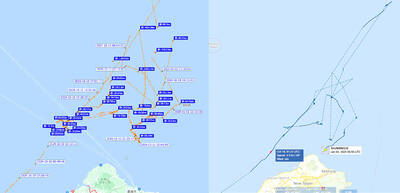The Chinese Nationalist Party (KMT) had the most income last year of any political party, despite about half being restricted as part of investigations into ill-gotten assets, while the Taiwan People’s Party (TPP) turned a profit.
The Ministry of the Interior yesterday released data on party finances for last year.
The KMT reported more than NT$1.1 billion (US$33.95 million) in income, although access to about NT$568 million was restricted by the Ill-gotten Party Assets Settlement Committee.

After subtracting the restricted amount, the KMT still had the most income at NT$530 million.
By income type, NT$125 million came from party dues, NT$153 million was from donations — the highest among the three major parties — and NT$246 million was from political party subsidies.
The Democratic Progressive Party (DPP) reported income of NT$509 million.

About NT$133 million was from dues and NT$256 million was from subsidies — both more than the KMT — while NT$116 million came from donations.
However, DPP expenditures totaled NT$719 million, resulting in a shortfall of about NT$211 million.
The TPP reported income of NT$183 million and expenditures of NT$158 million, making it the only major party to turn a profit.

Income mainly came from donations (NT$84.3 million) and subsidies (NT$79.1 million), while NT$18.6 million came from dues.
Worth noting is that the TPP received more than NT$6.52 million in anonymous donations, about seven times that of the KMT.
Of the expenditures, the DPP spent the most on personnel costs at NT$212 million, compared to NT$115 million spent by the KMT and NT$34 million spent by the TPP.
The KMT and DPP spent a similar amount on campaign expenses at NT$147 million and NT$142 million respectively.
The TPP only spent NT$7.07 million on campaign expenses, although they have not yet been properly detailed.
Not including expenses related to court-ordered disposal of ill-gotten assets totaling NT$670 million, the KMT’s expenditures amounted to NT$525 million.

DEEPER REVIEW: After receiving 19 hospital reports of suspected food poisoning, the Taipei Department of Health applied for an epidemiological investigation A buffet restaurant in Taipei’s Xinyi District (信義) is to be fined NT$3 million (US$91,233) after it remained opened despite an order to suspend operations following reports that 32 people had been treated for suspected food poisoning, the Taipei Department of Health said yesterday. The health department said it on Tuesday received reports from hospitals of people who had suspected food poisoning symptoms, including nausea, vomiting, stomach pain and diarrhea, after they ate at an INPARADISE (饗饗) branch in Breeze Xinyi on Sunday and Monday. As more than six people who ate at the restaurant sought medical treatment, the department ordered the

A strong continental cold air mass and abundant moisture bringing snow to mountains 3,000m and higher over the past few days are a reminder that more than 60 years ago Taiwan had an outdoor ski resort that gradually disappeared in part due to climate change. On Oct. 24, 2021, the National Development Council posted a series of photographs on Facebook recounting the days when Taiwan had a ski resort on Hehuanshan (合歡山) in Nantou County. More than 60 years ago, when developing a branch of the Central Cross-Island Highway, the government discovered that Hehuanshan, with an elevation of more than 3,100m,

Taiwan’s population last year shrank further and births continued to decline to a yearly low, the Ministry of the Interior announced today. The ministry published the 2024 population demographics statistics, highlighting record lows in births and bringing attention to Taiwan’s aging population. The nation’s population last year stood at 23,400,220, a decrease of 20,222 individuals compared to 2023. Last year, there were 134,856 births, representing a crude birth rate of 5.76 per 1,000 people, a slight decline from 2023’s 135,571 births and 5.81 crude birth rate. This decrease of 715 births resulted in a new record low per the ministry’s data. Since 2016, which saw

SECURITY: To protect the nation’s Internet cables, the navy should use buoys marking waters within 50m of them as a restricted zone, a former navy squadron commander said A Chinese cargo ship repeatedly intruded into Taiwan’s contiguous and sovereign waters for three months before allegedly damaging an undersea Internet cable off Kaohsiung, a Liberty Times (sister paper of the Taipei Times) investigation revealed. Using publicly available information, the Liberty Times was able to reconstruct the Shunxing-39’s movements near Taiwan since Double Ten National Day last year. Taiwanese officials did not respond to the freighter’s intrusions until Friday last week, when the ship, registered in Cameroon and Tanzania, turned off its automatic identification system shortly before damage was inflicted to a key cable linking Taiwan to the rest of